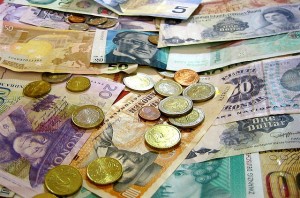How foreign is your new currency?
 So you’re moving abroad? Regardless of where your destination is, there is one thing you need to consider: currency. The exchange rate between your home country and your destination country can mean either a more economic lifestyle or a much more expensive one. Unfortunately, exchange rates change dramatically every day without notice and it is almost impossible to keep up with what is going on.
So you’re moving abroad? Regardless of where your destination is, there is one thing you need to consider: currency. The exchange rate between your home country and your destination country can mean either a more economic lifestyle or a much more expensive one. Unfortunately, exchange rates change dramatically every day without notice and it is almost impossible to keep up with what is going on.
Getting used to a foreign currency can take a while, but with time you will get used to it and life will get easier. There are 180 currencies in the world so make sure, first and foremost, that you know the currency they are using in your destination country – this should be fairly easy with a quick web search. You can also download a currency exchange rate app on your smartphone to help you convert your currency on the go.
The most traded currencies in the world today are:
- United States Dollar (USD $)
- European Euro (EUR €)
- Japanese Yen (JPY ¥)
- Pound Sterling (GBP £)
- Australian Dollar (AUD $)
- Swiss Franc (CHF Fr.)
- Canadian Dollar (CAD $)
- Hong Kong Dollar (HKD $)
- Swedish Krona (SEK kr)
- New Zealand Dollar (NZD $)
How (in)expensive is your new life?
Exchange rates will determine whether your destination country is more expensive or more economic to live in. Before embarking on your new adventure, make sure you do a quick search to see what type of living expenses you can afford to have abroad. Some countries might have cheaper food and transportation, but more expensive electronics, and vice versa. In first world countries, however, you should consider that what you pay for a big flat at home might barely get you a room abroad.
There are plenty of websites out there (such as Numbeo) where you can compare the costs of basic necessities between two countries. For example, the cost of 1 litre of milk:
- United States: $1.19 USD
- United Kingdom: £0.91, which equals to $1.44 USD
- Mexico: $15.04 mxn, which equals to $0.88 USD
- Japan: 183.80 ¥, which equals to $1.54 USD
- Saudi Arabia: 4.70 ﷼, which equals to $1.25 USD
- India: 42.38 Rs, which equals to $0.64 USD
Like this, you can compare other expenditures such as rent, transportation, health care and even clothing to get a general idea of your future expenses.
Plan a budget!
Now that you’ve searched the web and compared the costs of living, you are ready to plan a budget. If you are heading abroad for work and already know how much you will be paid (and in what currency), make sure you calculate how much you can spend on rent, school, transport, amongst other things. If you are moving on an adventurous hunch and have no idea what lays ahead, make sure you have calculated your savings to the last cent – especially if you want to treat yourself to an expensive dinner or a movie night out!
Most importantly, once you are abroad and living your life fully immersed in the new culture, stop comparing and start enjoying! Don’t get caught in the vicious “this costs more/less back home” cycle. You’re already there and you might as well live life to the fullest!
[Image: Philip Brewer]



